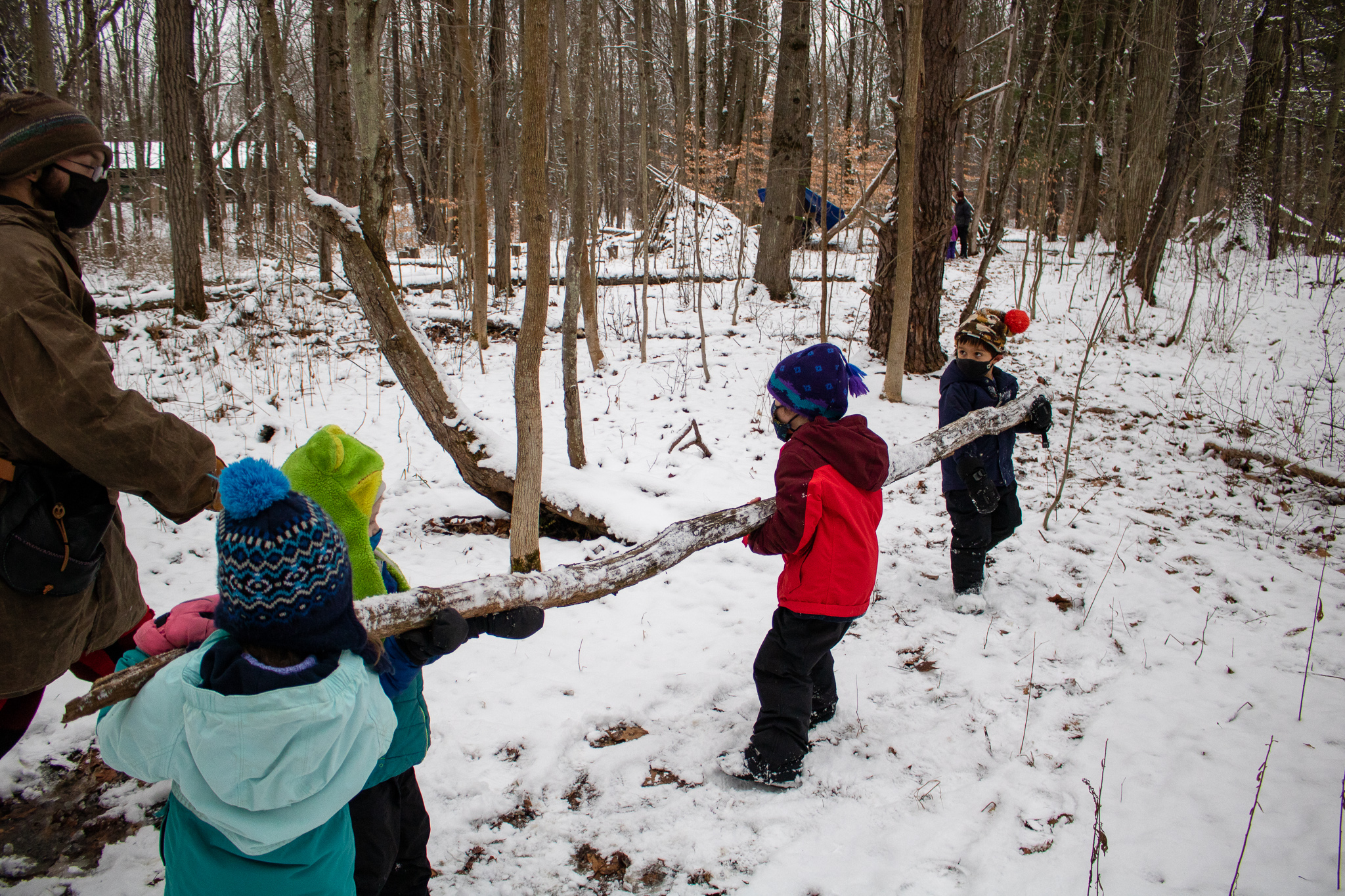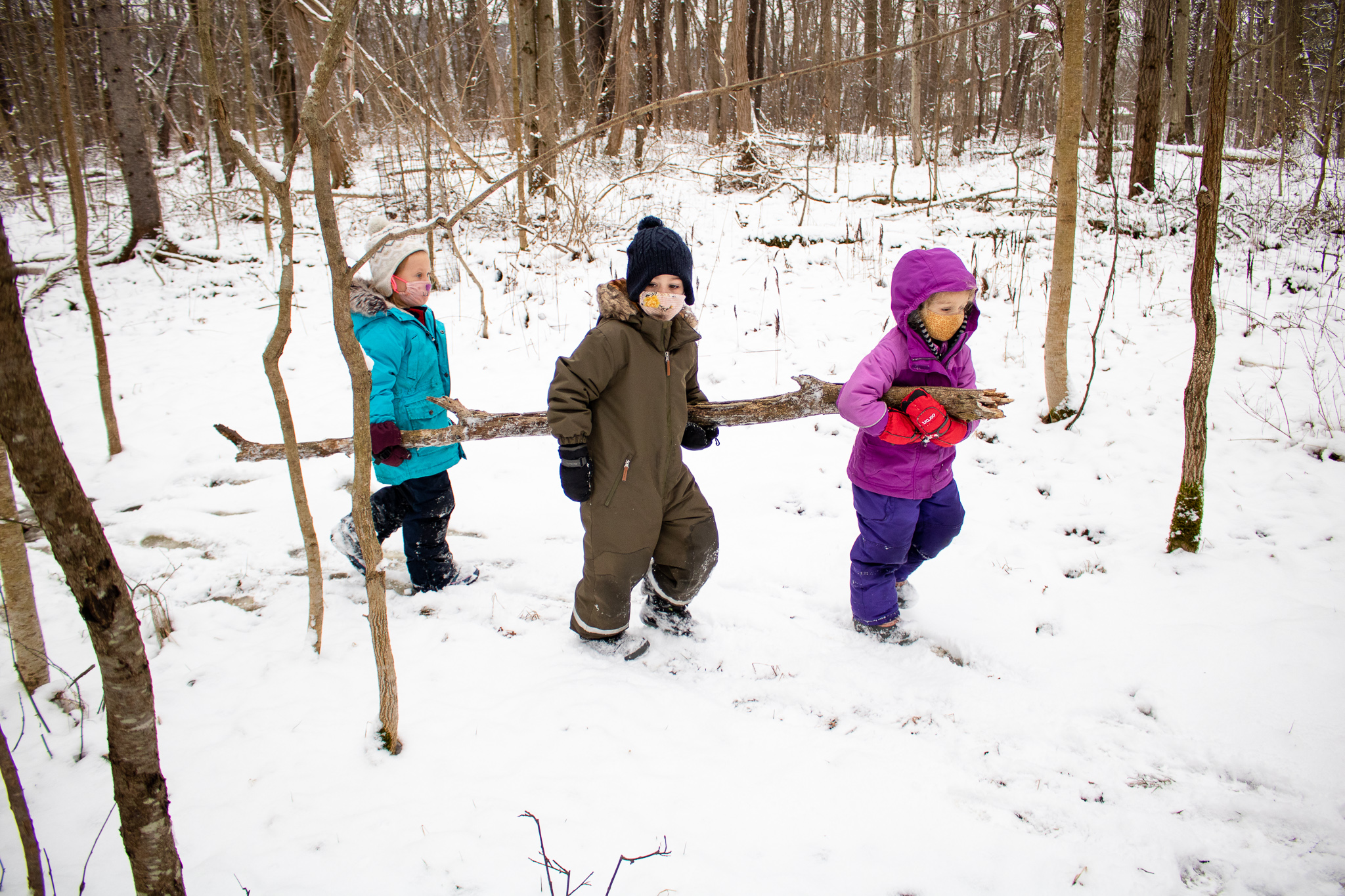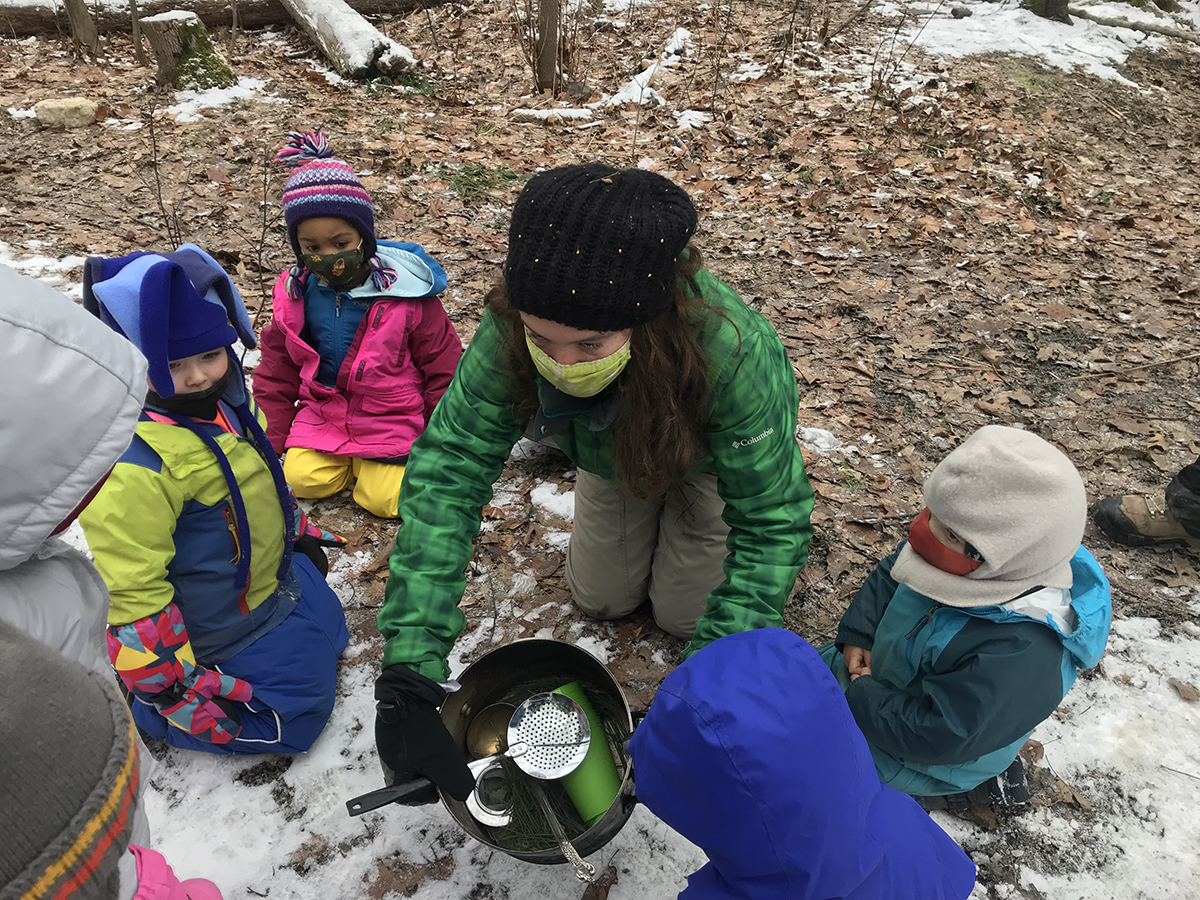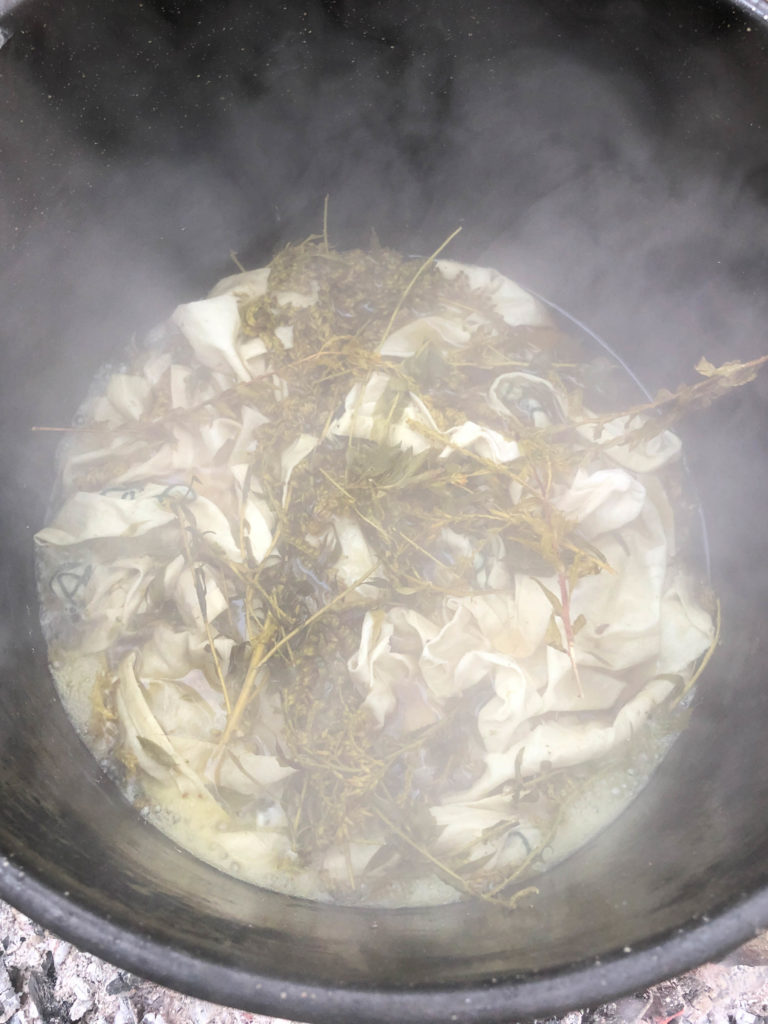“This animal is extremely adaptable and can live in a lot of different environments, including the one we’re in now. It eats small rodents, amphibians, birds and plants and it has red fur on its body,” said Eli while holding up a picture of a track that had four toes with a claw mark above each one. The children shared their guesses about what this animal could be but the Chickadee instructors kept it a mystery. Sarah then led the group through a “movement story” — a story the narrator tells using movements or actions that the listeners copy. “You wake up in the early morning right before the sun rises and are hungry. You move slowly on four legs, stopping to sniff and listen every once in a while. You suddenly hear something underneath the snow and pounce on it!” The Chickadees pretended to jump on their prey and when they caught it, they were instructed to bring it to their den because they had young mouths to feed. After pouncing on their prey, it was time to rest. “You find a cozy place to sleep right on the snow and use your long, fluffy tail to protect your face while you sleep.”
When the Chickadees stopped at the top of the bridge on Monday morning and were asked what had changed since the last time they were at Trillium Camp, almost everyone said “ice!” The creek was partially frozen! The instructors carefully tested the ice to make sure it was strong enough to hold their weight and used long sticks to mark off areas for the Chickadees to avoid. The forest was filled with giggles and squeals of delight as the children slid on their knees, bellies or bottoms on the slippery ice.
It’s slunch time, it’s slunch time
It’s time to eat our slunch
It’s slunch time, it’s slunch time
It’s time to munch and crunch!
When the Chickadees hear this song, they know it’s time to get in line for handwashing and join the flock in the log circle to eat some food, drink some water and listen to a story. Nora told an epic tale of the time Willa and the other winter fairies made it snow all day long. It snowed so much that the entire forest was covered in a thick blanket of white, fluffy snow. It takes a lot of work to make it snow all day and Willa was feeling tired. But as she was making her way back to her ice castle, she heard a cry coming from somewhere in the distance. Even though Willa was tired and dreaming of the warm bed waiting for her at home, she knew it was important to help others when possible. She flew in the direction of the cries and saw an animal in a clearing with a big, fluffy tail with white fur on the tip and large, pointed ears. “Rosa the red fox! What’s wrong?” asked Willa. Rosa explained that she was hungry but had never hunted in the winter before. “How am I supposed to find all of the tasty mice with all this snow covering up the forest floor? I can’t see or smell anything!” Willa taught Rosa how to use her ears to listen to the animals living in the subnivean zone (the area between the ground and the bottom of the snowpack) and how to walk quietly, or fox-walk, so these animals couldn’t hear her. After waiting, listening and fox-walking, Rosa was ready to pounce on her prey. Willa showed her how to jump in the air and dive headfirst into the snow. Rosa gave it a try and happily came out of the snow pile with a mouse in her mouth!
In Closing Circle, the children learned a new song called “The Wolf, the Fox and the Weasel.” This song is based on a traditional French song called “La Jument de Michao.” The lyrics are below so you can sing it together at home!
I hear the wolf and the fox and the weasel
I hear the wolf and the fox singing (repeat both lines twice)
And in ten years I will come back
I hear the wolf and the fox singing (repeat both lines twice)
“All-in Chickadees,” Hannah called on Tuesday morning. The children ran to the log circle, sat down and suddenly heard a familiar sound coming from the trees around them — chickadees! “We must have called in the chickadees of a forest when we yelled ‘all-in,'” said Hannah. The children listened to their calls and tried to catch a glimpse of this tiny but brave bird. “I hear the chickadees’ song but not their alarm call,” said a child. Hannah and Sarah looked at each other in amazement. The flock learned about the difference between chickadee songs and alarm calls in the fall, but it had been awhile since they had talked about it.
Tuesday’s Opening Circle had even more surprises in store! Eli and Sarah each brought special rocks to show the group — one was light and had holes in it and the other was smooth and shiny. After sanitizing hands, the children passed the rocks around the circle and described what they felt like. “This one is sharp,” “it feels like rubber,” “it’s smooth,” were some of the wonderful descriptive words the Chickadees used. Eli explained that he brought a kind of volcanic rock called pumice that is formed when gas gets trapped in lava. When that lava cools it leaves behind a rock with lots of holes in it. Sarah held up her rock and said that it’s called obsidian and it’s formed from lava that cooled very quickly.
You’re probably wondering what inspired all this talk about lava! Last week during slunch, Hannah talked about a volcano in Hawaii that had erupted and created a lake filled with lava! The children were really intrigued by this so the Chickadee instructors wanted to spend more time talking about it. Which brings us back to Tuesday’s Opening Circle when Eli made a volcano erupt. Yes, you read that right! After everyone had a chance to look at the pieces of pumice and obsidian, Eli brought out a bottle with a funnel on top. The Chickadees watched as he poured in some baking soda and suddenly reddish orange lava came gushing out! Afterwards, the children gathered around the “volcano” to take a closer look. They noticed the “lava” had gotten on the ground and was touching some charcoal from a past fire. “The lava is turning into pumice!,” some of the children said.
“I saw a gray, bushy tail coming down the trunk of the white pine tree,” Sarah said during Wednesday’s slunch story. “At first I thought it was a gray squirrel, but the tail was much bigger and longer than a tail belonging to a squirrel. I watched as this animal climbed down the tree and I was amazed to see that it was a fox, a gray fox!.” During that morning’s Opening Circle, the children got to examine a gray fox skull. They noticed how it had both pointed, sharp teeth for tearing and flatter teeth for grinding. They also pointed out where its brain, eyes and nose had been. This skull, along with other bones and a red fox hide, were shared with Ithaca Forest Preschool by Hillary-Joy, a Primitive Pursuits Homeschool instructor. Thank you Hillary-Joy! 🙂
Do you remember the chestnuts we cached last week? On Wednesday, Eli showed us how to roast them over the fire! When they were ready, each child got to try one and while many didn’t like the taste, the Chickadee instructors were so proud of them for trying something new! There were several uncooked chestnuts left so the flock decided to walk like sneaky foxes up to Turkey Knoll and deliver them to the Nuthatches. When they got past the Horsey Log, they would see that the Nuthatches weren’t in their camp. The Chickadees fox-walked over to the other flock’s log circle and left the basket with chestnuts there for them to find. When the children ran down the hill back to Trillium Camp, they noticed something strange — pieces of wood on our firewood box that we hadn’t gathered! Who do you think left these for us?
“I notice that the hair on top is more coarse and rough than the hair underneath,” said Nora while feeling a red fox tail during Thursday’s Opening Circle. The children each got to touch the red fox tail on the hide that Hillary-Joy shared with preschool. Afterwards they sang “The Wolf, the Fox and the Weasel” song while dancing and jumping around the log circle. Once in Trillium Camp, the children enjoyed climbing and sliding down the Climbing Hill and building Willa’s ice castle using pieces of ice from the creek. When the slunch time song was sung and hands were washed, everyone met in the log circle and listened to Nora tell a story called Tomten and the Fox. The Chickadees loved it and are hoping to hear more stories about Tomten, a small gnome-like creature from Swedish folklore. During slunch, Hannah led an interesting discussion about snakes. They talked about garter snakes, northern water snakes and rattlesnakes!
When it was time to end our day and week at preschool, the children helped clean up camp by picking up all of the pots, pans and baskets and headed over to the log circle where they each picked out an instrument. One of the Chickadees had a special song he wanted to share with the flock called “A Stone Bridge,” which is sung in Romanian. The lyrics are written below in English.
A stone bridge was destroyed
And washed by flowing water
We will build another one, downstream on the river
It will be stronger and more beautiful



























































Recent Comments